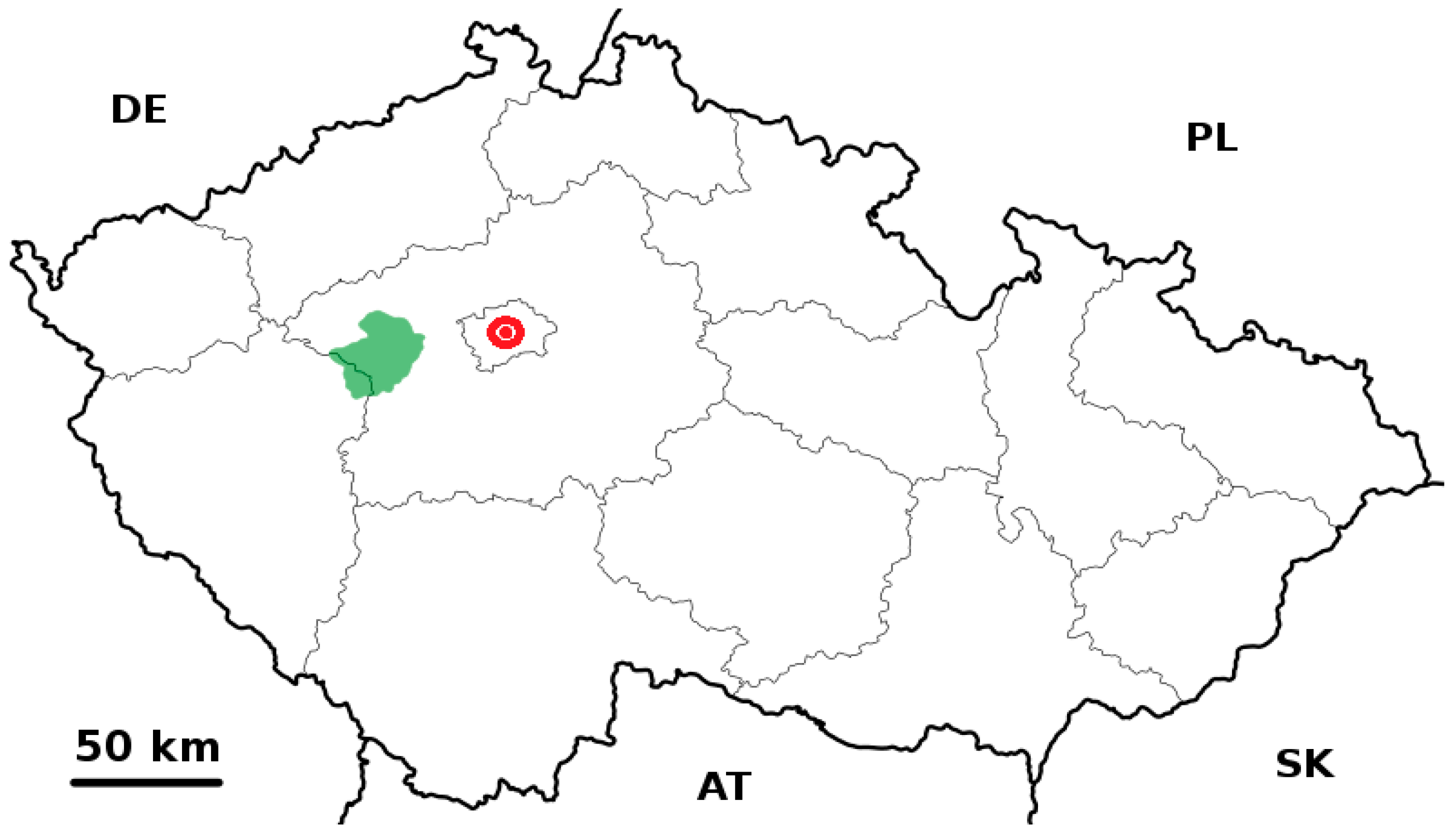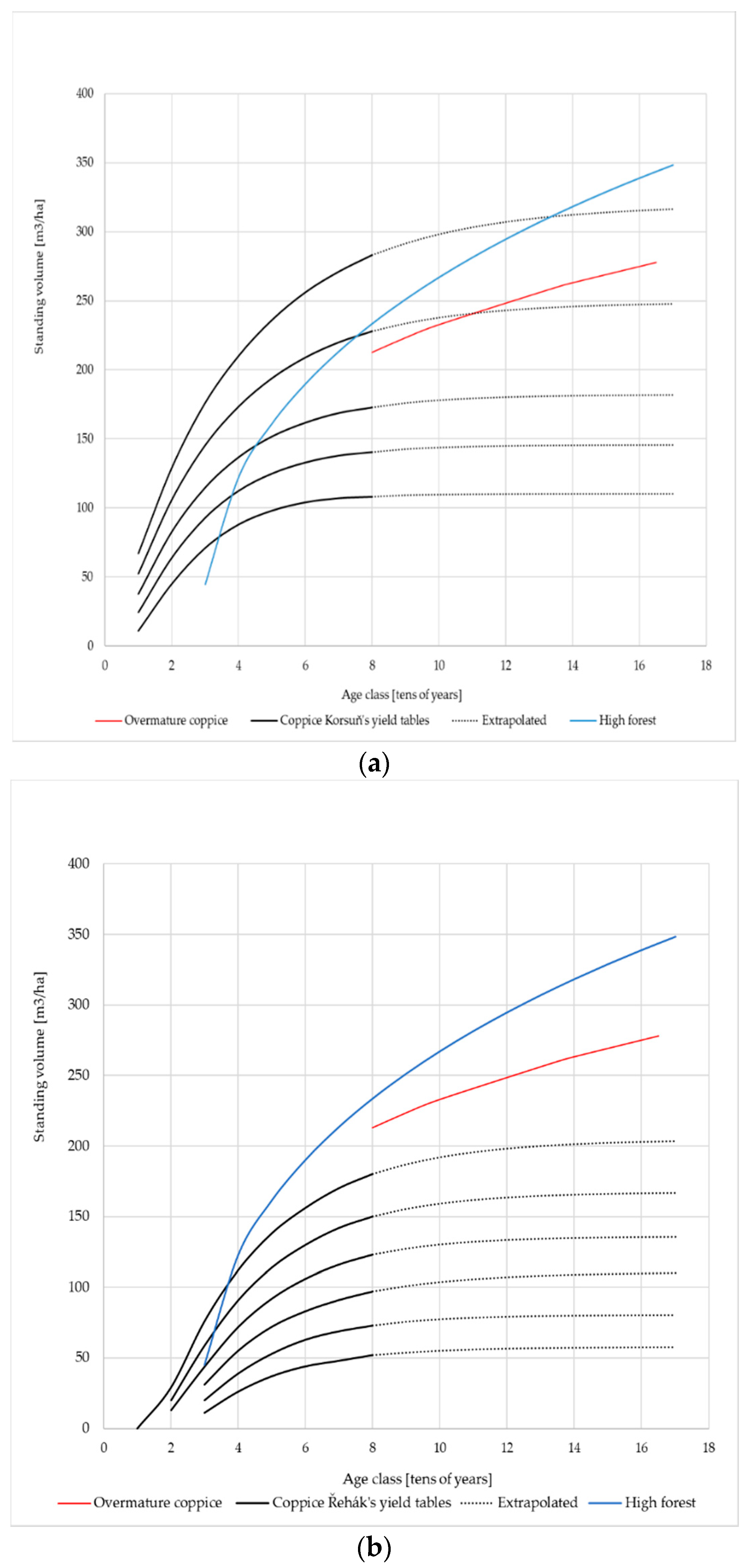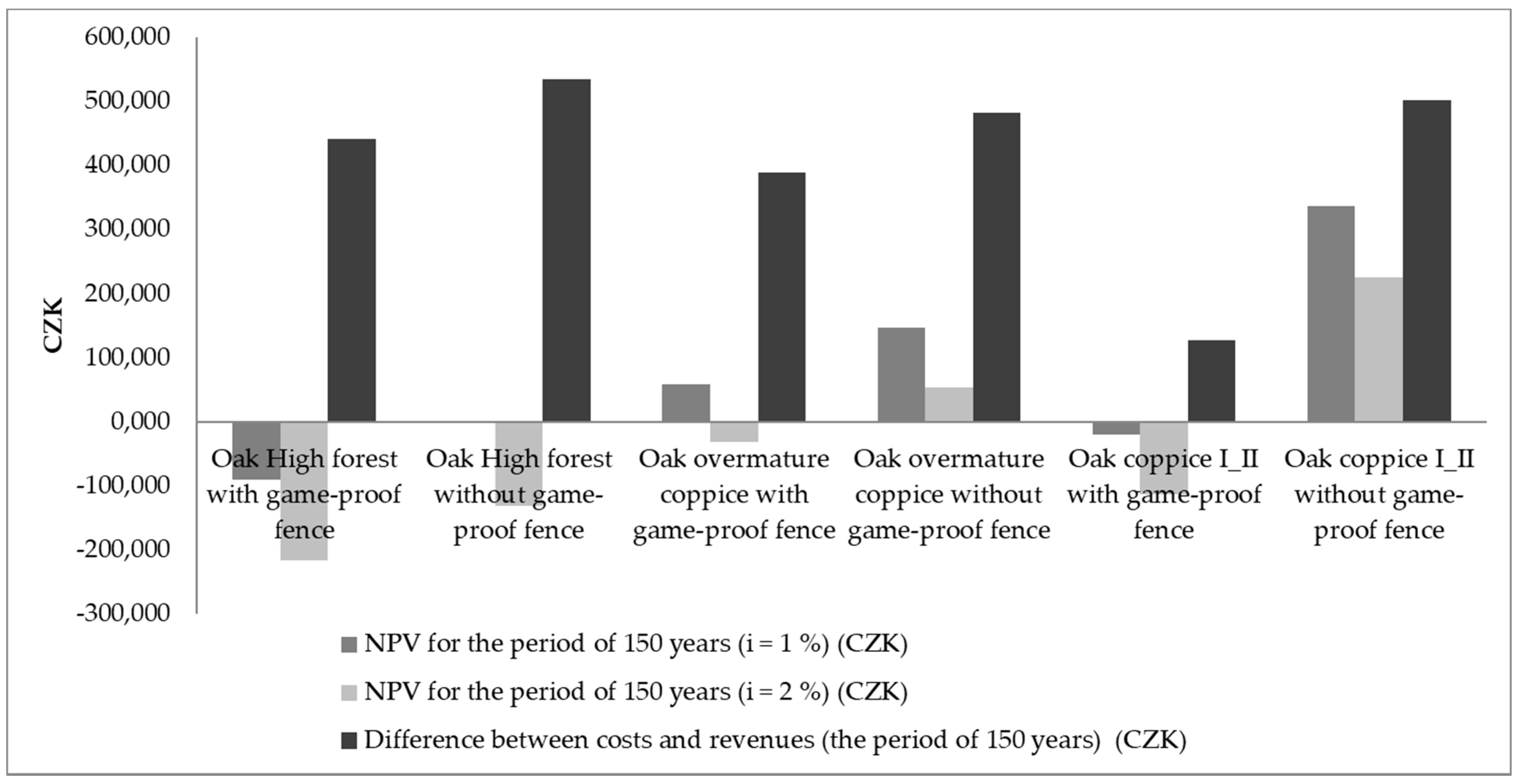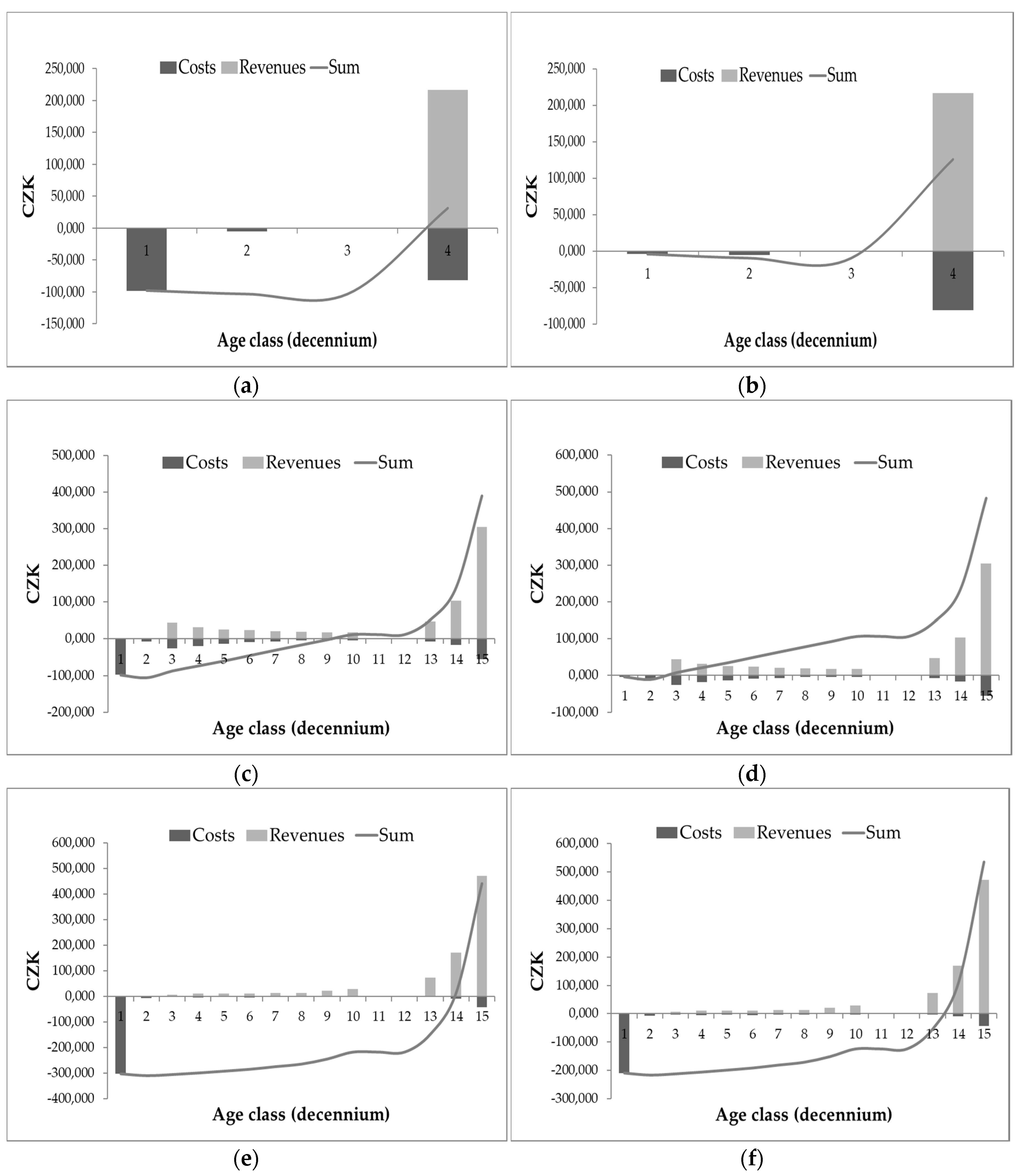Comparison of Economic Efficiency of Management Systems with Prevailing Representation of Sessile Oak (Quercus petraea (Matt.) Liebl.) in the Territory of Křivoklátsko Forest Park (Czech Republic)
Abstract
:1. Introduction
2. Materials and Methods
2.1. Characteristics of the Analyzed Area
2.2. Work Methodology
- 1:
- High forest—with a game-proof fence,
- 2:
- High forest—without a game-proof fence,
- 3:
- Over-mature coppice—with a game-proof fence,
- 4:
- Over-mature coppice—without a game-proof fence,
- 5:
- Coppice—site interclass I/II [16], with a game-proof fence,
- 6:
- Coppice—site interclass I/II [16], without a game-proof fence.
3. Results
4. Discussion
5. Conclusions
- In better site indexes, the economic efficiency of a coppice could be higher than that of a high forest or over-mature coppice.
- The option number 6 with the time factor, i.e., coppice—interclass I/II [16], without a game-proof fence, gives the best results.
- Coppice cultivation is economically viable only in the best site indexes or at localities with reasonable cloven-hoofed game population, where game-proof fences are not necessary, or where other means of protection against damages caused by game are used.
- Cultivation of over-mature coppices might become an economically interesting alternative.
- In the case of high forests, the values reach negative levels (calculations with time factor) due to the high initial costs of establishment or protection of the new forest stand as well as due to the use of a relatively long rotation period (150 years in the examined options).
Author Contributions
Funding
Acknowledgments
Conflicts of Interest
References
- Žák, K.; Majer, M.; Hůla, P.; Cílek, V. (Křivoklátsko—Příběh Královského Hvozdu [Křivoklátsko: The Story of King’s Forest], 1st ed.; Dokořán: Prague, Czech Republic, 2016; 318p, ISBN 978-80-7363-762-0. [Google Scholar]
- LP Křivoklátsko. [Křivoklátsko Forestry Park] (KFP). Available online: http://www.lpkrivoklatsko.cz/summary.html (accessed on 15 March 2020).
- Kopecký, M. Křivoklátsko—Sledování Vývoje Krajiny na Starých Mapách [Křivoklátsko: Tracking of Landscape Evolution Using Old Maps. Bachelor’s Thesis, Czech Technical University in Prague, Prague, Czech Republic, 2011; 52p. [Google Scholar]
- LHP Křívoklátsko [Forest Management Plans of owners from area Forest Park Křivoklátsko]. Private source of information from LP Křivoklátsko. Private communication, 2019.
- Maděra, P.; Buček, A.; Úradníček, L.; Slach, T.; Friedl, M.; Machala, M.; Řepka, R.; Lacina, J.; Černušáková, L.; Volařík, D. Starobylé Výmladkové Lesy, Jejich Význam a Udržitelnost v Kulturní krajině [Ancient Sprout Forests: Importance and Sustainability in Cultivated Landscapes]; Certified methodology; Mendel University in Brno: Brno, Czech Republic, 2016. [Google Scholar]
- Skopeček, J. Dynamika a Příčiny Hospodaření s Křivoklátskými Lesy od Poloviny 18. Století do Roku 1939 [Dynamics and Causes of Management of Krivoklat Forests from the Mid. 18th Century to 1939]. Master’s Thesis, Charles University in Prague, Prague, Czech Republic, 2008; 103p. [Google Scholar]
- Lesprojekt Hradec Králové s. r. o. Lesní Hospodářský Plán Křivoklát 2005–2014 [Forest Management Plan Křivoklát 2005–2014]; Textual part; Lesprojekt Hradec Králové s.r.o.: Hradec Králové, Czech Republic, 2004. [Google Scholar]
- Müllerová, J.; Szabó, P.; Hédl, R. The rise and fall of traditional forest management in southern Moravia: A history of the past 700 years. For. Ecol. Manag. 2014, 331, 104–115. [Google Scholar] [CrossRef] [PubMed] [Green Version]
- McGrath, M.J.; Luyssaert, S.; Meyfroidt, P.; Kaplan, J.O.; Bürgi, M.; Chen, Y.; Erb, K.; Gimmi, U.; McInerney, D.; Naudts, K.; et al. Reconstructing European forest management from 1600 to 2010. Biogeosciences 2015, 12, 4291–4316. [Google Scholar] [CrossRef] [Green Version]
- Matthews, J.D. Silvicultural Systems; Oxford University Press: Oxford, UK, 1991. [Google Scholar]
- Buckley, G.P. Ecology and Management of Coppice Woodlands; University Press: Cambridge, UK, 1992. [Google Scholar]
- Lindner, M.; Fitzgerald, J.B.; Zimmermann, N.E.; Reyer, C.; Delzon, S.; van der Maaten, E.; Schelhaas, M.-J.; Lasch, P.; Eggers, J.; van der Maaten-Theunissen, M.; et al. Climate change and European forests: What do we know, what are the uncertainties, and what are the implications for forest management? J. Environ. Manag. 2014, 146, 69–83. [Google Scholar] [CrossRef] [PubMed] [Green Version]
- Puettmann, K.J.; Wilson, S.M.G.; Baker, S.C.; Donoso, P.J.; Drössler, L.; Amente, G.; Harvey, B.D.; Knoke, T.; Lu, Y.; Nocentini, S.; et al. Silvicultural alternatives to conventional even-aged forest management—What limits global adoption? For. Ecosyst. 2015, 2, 2–16. [Google Scholar] [CrossRef] [Green Version]
- IPCC. Climate Change 2013, the Physical Science Basis. Contribution of Working Group I to the Fifth Assessment Report of the Intergovernmental Panel on Climate Change; Cambridge University Press: Cambridge, UK, 2013. [Google Scholar]
- IMFN. International Model Forest Network: What is a Model Forest? Available online: https://imfn.net/model-forest/ (accessed on 15 March 2020).
- Korsuň, F. Život dubových pařezin v číslicích [Life of Oak Coppices in Figures]. Pap. Czechoslov. For. Res. Inst. 1954, 6, 154–190. [Google Scholar]
- Řehák, J. Úprava Růstových Tabulek Pro Výmladkový Dub, Olši a Habr [Adjustment of Growth Tables for Oak, Alder, and Hornbeam Sprouts]; Final report; VŠZ in Prague. Forest Research Instute in Kostelec Nad Černými Lesy: Prague, Czech Republic, 1981; 41p. [Google Scholar]
- Pienaar, L.V.; Turnbull, K.J. The Chapman-Richards generalization of von Bertalanffy’s growth model for basal area growth and yield in even-aged stands. For. Sci. 1973, 19, 2–22. [Google Scholar]
- Hlásny, T.; Barcza, Z.; Fabrika, M.; Balázs, B.; Churkina, G.; Pajtík, J.; Sedmák, R.; Turčáni, M. Climate change impacts on growth and carbon balance of forests in Central Europe. Clim. Res. 2011, 47, 219–236. [Google Scholar] [CrossRef] [Green Version]
- Mikita, T.; Čermák, P.; Trnka, M.; Jurečka, F. Modelování Podmínek pro Pěstování Smrku, Buku a Dubu [Modelling Conditions for Spruce, Beech, and Oak Cultivation]. FRAMEADAPT—Frameworks and Possibilities of Forest Adaptation Measures and Strategies Connected with Climate Change. Technical Report 1.4. 2016. Available online: https://www.researchgate.net/publication/337276121_Modelovani_podminek_pro_pestovani_smrku_buku_a_dubu (accessed on 18 February 2020).
- Pietras, J.; Stojanović, M.; Knott, R.; Pokorný, R. Oak sprouts grow better than seedlings under drought stress. iForest Biogeosci. For. 2016, 552. [Google Scholar] [CrossRef] [Green Version]
- Stojanović, M.; Čater, M.; Pokorný, R. Responses in young Quercus petraea: Coppices and standards under favourable and drought conditions. Dendrobiology 2016, 76, 127–136. [Google Scholar] [CrossRef]
- Stojanović, M.; Szatniewska, J.; Kyselová, I.; Pokorný, R.; Čater, M. Transpiration and water potential of young Quercus petraea (M.) Liebl. coppice sprouts and seedlings during favourable and drought conditions. J. For. Sci. 2017, 63, 313–323. [Google Scholar]
- Stojanović, M.; Sánchez-Salguero, R.; Levanič, T.; Linares, J.C.; Szatniewska, J.; Pokorný, R.; Linares, J.C. Forecasting tree growth in coppiced and high forests in the Czech Republic. The legacy of management drives the coming Quercus petraea climate responses. For. Ecol. Manag. 2017, 405, 56–68. [Google Scholar] [CrossRef]
- Matějíček, J.; Šafařík, D.; Vala, V.; Sebera, J.; Lenoch, J. Úroková Míra v Lesnictví. [The Forestry Interest Rate]; Lesnická práce, s. r. o.: Kostelec Nad Černými Lesy, Czech Republic, 2013; 160p. [Google Scholar]
- Endres, M. Lehrbuch der Waldbewertrechnung und Forststatik; Auflage: Berlin, Germany, 1923; Available online: https://docplayer.cz/69182702-Trzni-realizace-mimoprodukcnich-funkci-lesa.html (accessed on 31 December 2016).
- Decree No. 441/2013 Coll., Implementing the Property Valuation Act (Valuation Decree), as Amended. Available online: https://www.zakonyprolidi.cz/cs/2013-441 (accessed on 15 March 2020).
- Moog, M.; Bösch, M. Interest rates in the German forest valuation literature of the early nineteenth century. For. Policy Econ. 2013, 30, 1–5. [Google Scholar] [CrossRef]
- Mantel, W. Waldbewertung, Einführung und Anleitung. 5. Neubearbeitete Auflage; Bayerischer Landwirtshaftsverlag München Basel: Wien, Austria, 1968; 308p. [Google Scholar]
- Tutka, J.; Vilček, J.; Kovalčík, M. Oceňovanie Lesa. [Forest Valuation]; The Insitute for Education and Training for Staffs of the Forest and Water Management: Zvolen, Czech Republic, 2003; 254p. [Google Scholar]
- Jančík, A. Dějiny lesního závodu VŠZ v Brně. A) Adamovské lesy. 2. Od Smrti Aloise I. Liechtenštejna 1805 do nastoupení Jana II. Liechtenštejna 1858. [History of Forest Enterprise VŠZ in Brno. A) Adamov Forests. 2. From the Death of Aloys I, Prince of Liechtenstein, to the Beginning of Reign of John II, Duke of Liechtenstein, in 1858]; VŠZ Brno. Křtiny Forest Enterprise, Mendel University in Brno: Brno, Czech Republic, 1960; 201p. [Google Scholar]
- Frič, J. Zařízení lesů [Forest Management]; Československá Matice Lesnická: Písek, Czech Republic, 1947; 516p. [Google Scholar]
- Styles, D.; Thorne, F.; Jones, M. Energy crops in Ireland: An economic comparison of willow and Miscanthus production with conventional farming systems. Biomass Bioenergy 2008, 32, 407–421. [Google Scholar] [CrossRef]
- Gasol, M.C.; Brun, F.; Mosso, A.; Rieradevall, J.; Gbarrell, X. Economic assessment and comparison of acacia energy crop with annual traditional crops in Southern Europe. Energy Policy 2009, 38, 592–597. [Google Scholar] [CrossRef]
- Le Goff, N.; Garros, L.; Canta, R. Indice de productivité des tailis sous futaie de chene dans la région centre. Ann. Sci. For. 1984, 41, 1–34. [Google Scholar] [CrossRef] [Green Version]
- Dubourdieu, J. L’intéret de la conversion des tailis-sous-futaie en futaie et ses limites. Rev. For. Fr. 1991, 43, 146–161. [Google Scholar]
- Schütz, J.P.; Rotach, P. Mittelwaldbetrieb: Nostalgische Illusion oder zukunftsträchtiges Waldbaukonzept? Wald Und Holz 1993, 74, 8–12. [Google Scholar]
- Suchant, R.; Opeker, K.; Nain, W. Der Kirschen—Mittelwald: Ökonomische und ökologische Alternative für den Niederwald. Allg. Forst-Und Jagdztg. 1995, 167/7, 139–148. [Google Scholar]
- Hochbichler, E. Fallstudien zur Struktur, Produktion und Bewirtschaftung von Mittelwäldern im Osten Österreichs (Weinviertel). Band 20. Österreichische Gesellschaft für Waldökosystemforschung und Experimentelle Baumforschung. Ph.D. Thesis, Universität für Bodenkultur, Wien, Austria, 2008; 245p. [Google Scholar]
- Kneifl, M.; Kadavý, J. Modelové srovnání výnosovosti nízkého a vysokého dubového lesa [Model Comparison of Oak Coppice and Oak High Forest Profitability]. [CDROM]. In Nízké a střední lesy v krajině [Coppice and High Forests in Landscape]; Mendel University in Brno: Brno, Czech Republic, 2009; ISBN 978-80-7375-292-7. [Google Scholar]
- Kneifl, M.; Kadavý, J.; Knott, R. Gross Value Yield Potential of Coppice, High Forest and Model Conversion of High Forest to Coppice on Best Sites. J. For. Sci. 2011, 57, 536–546. [Google Scholar] [CrossRef] [Green Version]
- Amorini, E.; Fabbio, G.; Gambi, G. Thinning regime for coppice stands for conversion to high forest. Experimental trials for multiple use with grazing. Ann. Dell’ist. Sper. Selvic. Italy 1979, 10, 1–23. [Google Scholar]
- Piegai, F.; Fabiano, F. Harvesting of firewood at coppice clearcutting and at first thinning for coppice conversion into high forest. Ann. Dell’ist. Sper. Selvic. 2002, 33, 51–62. [Google Scholar]
- Piegai, F. Utilization and conversion in oak coppice: Productivity compared. Sherwood For. Alberi Oggi 2005, 5–8. Available online: https://www.cabdirect.org/cabdirect/abstract/20063011218 (accessed on 1 March 2020).
- Picchio, R.; Maesano, M.; Savelli, S.; Marchi, E. Productivity and energy balance in conversion of a Quercus cerris L. coppice stand into high forest in Central Italy. Croat. J. For. Eng. 2009, 30, 15–26. [Google Scholar]
- Marca, O. Research into the exploitation of Turkey oak woods in Italy. Cellul. Carta 1992, 43, 28–32. [Google Scholar]
- Vassilev, Z. On the economic effectiveness of reconstructions of low productivity coppice forests. In Proceedings of the Jubilee Symposium Marking 125 Years of the Bulgarian Academy of Sciences and 65 Years of the Forest Research Institute Sofia Bulgaria, Sofia, Bulgaria, 22–23 September 1994; pp. 126–130. [Google Scholar]
- Durkaya, A.; Durkaya, B.; Cetin, M. Conversion possibilities of oak (Quercus sp. L.) coppices into high forests in Bartin, Turkey. Bartin Orman Fak. Derg. 2009, 11, 51–59. [Google Scholar]
- Doležal, J.; Mazůrek, P.; Klimešová, J. Oak decline in southern Moravia: The association between climate change and early and late wood formation in oaks. Preslia 2010, 82, 289–306. [Google Scholar]
- Mérian, P.; Bontemps, J.-D.; Bergès, L.; Lebourgeois, F. Spatial variation and temporal instability in climate-growth relationships of sessile oak (Quercus petraea [Matt.] Liebl.) under temperate conditions. Plant Ecol. 2011, 212, 1855–1871. [Google Scholar] [CrossRef]
- Rybníček, M.; Čermák, P.; Prokop, O.; Žid, T.; Trnka, M.; Kolář, T. Oak (Quercus spp.) response to climate differs more among sites than among species in central Czech Republic. Dendrobiology 2016, 75, 55–65. [Google Scholar] [CrossRef]




| Woody Plant | Spruce | Pine | Larch | Fir | Other Conifers | Conifers Total | Oak | Beech | Hornbeam | Other Broadleaf Species | Broadleaf Species Total |
|---|---|---|---|---|---|---|---|---|---|---|---|
| Conifers | 27 | 9 | 9 | 1 | 1 | 47 | - | - | - | - | - |
| Broadleaf species | - | - | - | - | - | - | 18 | 18 | 8 | 9 | 53 |
| Age Class | Stand Age (Years) | Time Since Beginning (Years) | Action | Unit | Quantity | Costs (CZK/Unit) | Costs (CZK Total) | Revenues (CZK/Unit) | Revenues (Total in CZK) |
|---|---|---|---|---|---|---|---|---|---|
| 1 | 1–10 | 1 | *1 | ths. | 10.000 | 8936 | 89,360 | - | - |
| 1 | 1–10 | 1 | *2 | ha | 1.00 | 4329 | 4329 | - | - |
| 1 | 1–10 | 1 | *3 | ha | 1.00 | 9474 | 9474 | - | - |
| 1 | 1–10 | 2 | *4 | ths. | 5.000 | 10,087 | 50,435 | - | - |
| 1 | 1–10 | 2 | *2 | ha | 1.00 | 4329 | 4329 | - | - |
| 1 | 1–10 | 2 | *3 | ha | 1.00 | 9474 | 9474 | - | - |
| 1 | 1–10 | 3 | *2 | ha | 1.00 | 4329 | 4329 | - | - |
| 1 | 1–10 | 3 | *3 | ha | 1.00 | 9474 | 9474 | - | - |
| 1 | 1–10 | 4 | *3 | ha | 1.00 | 9474 | 9474 | - | - |
| 1 | 1–10 | 5 | *3 | ha | 1.00 | 9474 | 9474 | - | - |
| 1 | 1–10 | 6 | *3 | ha | 1.00 | 9474 | 9474 | - | - |
| 209,626 | 0 | 0 | |||||||
| 2 | 11–20 | 15 | *5 | ha | 1.00 | 5525 | 5525 | - | - |
| 2 | 11–20 | 15 | *6 | km | 0.50 | 3184 | 1592 | - | - |
| 7117 | 0 | 0 | |||||||
| 3 | 21–30 | 25 | *7 | m3 | 13 | 216 | 2808 | 548 | 7124 |
| 2808 | 548 | 7124 | |||||||
| 4 | 31–40 | 35 | *7 | m3 | 20 | 211 | 4220 | 520 | 10,400 |
| 4220 | 520 | 10,400 | |||||||
| 5 | 41–50 | 45 | *8 | m3 | 20 | 170 | 3400 | 523 | 10,460 |
| 3400 | 523 | 10,460 | |||||||
| 6 | 51–60 | 55 | *8 | m3 | 21 | 203 | 4263 | 562 | 11,802 |
| 4263 | 562 | 11,802 | |||||||
| 7 | 61–70 | 65 | *8 | m3 | 20 | 125 | 2500 | 636 | 12,720 |
| 2500 | 636 | 12,720 | |||||||
| 8 | 71–80 | 75 | *8 | m3 | 19 | 119 | 2261 | 643 | 12,217 |
| 2261 | 643 | 12,217 | |||||||
| 9 | 81–90 | 85 | *8 | m3 | 18 | 108 | 1944 | 1207 | 21,726 |
| 1944 | 1207 | 21,726 | |||||||
| 10 | 91–100 | 95 | *8 | m3 | 19 | 118 | 2242 | 1553 | 29,507 |
| 2242 | 1553 | 29,507 | |||||||
| 11 | 101–110 | 105 | *9 | m3 | 0 | 98 | 0 | 1586 | 0 |
| 0 | 1586 | 0 | |||||||
| 12 | 111–120 | 115 | *9 | m3 | 0 | 98 | 0 | 1586 | 0 |
| 0 | 1586 | 0 | |||||||
| 13 | 121–130 | 125 | *9 | m3 | 44 | 70 | 3080 | 1663 | 73,172 |
| 3080 | 1663 | 73,172 | |||||||
| 14 | 131–140 | 135 | *9 | m3 | 98 | 84 | 8232 | 1736 | 170,128 |
| 8232 | 1736 | 170,128 | |||||||
| 15 | 141–150 | 150 | *9 | m3 | 268 | 93 | 24,924 | 1759 | 471,412 |
| 15 | 141–150 | 150 | *10 | m3 | 268 | 52 | 13,936 | - | - |
| 15 | 141–150 | 150 | *11 | ha | 1.00 | 4685 | 4685 | - | - |
| 43,545 | 1759 | 471,412 |
| Age Class | Stand Age (Years) | Time Since Beginning (Years) | Action | Unit | Quantity | Costs (CZK/Unit) | Costs (Total in CZK) | Revenues (CZK/Unit) | Revenues (Total in CZK) |
|---|---|---|---|---|---|---|---|---|---|
| 1 | 1–10 | 1 | *1 | ha | 1.00 | 4329 | 4329 | - | - |
| *2 | 4329 | 0 | 0 | ||||||
| 2 | 11–20 | 15 | *3 | ha | 1.00 | 5525 | 5525 | - | - |
| 2 | 11–20 | 15 | *4 | km | 0.50 | 3184 | 1592 | - | - |
| 7117 | 0 | 0 | |||||||
| 3 | 21–30 | 25 | *4 | m3 | 35 | 723 | 25,305 | 1250 | 43,750 |
| 25,305 | 1250 | 43,750 | |||||||
| 4 | 31–40 | 35 | *4 | m3 | 26 | 723 | 18,798 | 1250 | 32,500 |
| 18,798 | 1250 | 32,500 | |||||||
| 5 | 41–50 | 45 | *5 | m3 | 21 | 610 | 12,810 | 1250 | 26,250 |
| 12,810 | 1250 | 26,250 | |||||||
| 6 | 51–60 | 55 | *5 | m3 | 19 | 470 | 8930 | 1250 | 23,750 |
| 8930 | 1250 | 23,750 | |||||||
| 7 | 61–70 | 65 | *5 | m3 | 17 | 386 | 6562 | 1250 | 21,250 |
| 6562 | 1250 | 21,250 | |||||||
| 8 | 71–80 | 75 | *5 | m3 | 15 | 302 | 4530 | 1250 | 18,750 |
| 4530 | 1250 | 18,750 | |||||||
| 9 | 81–90 | 85 | *5 | m3 | 14 | 243 | 3402 | 1250 | 17,500 |
| 3402 | 1250 | 17,500 | |||||||
| 10 | 91–100 | 95 | *5 | m3 | 14 | 243 | 3402 | 1250 | 17,500 |
| 3402 | 1250 | 17,500 | |||||||
| 11 | 101–110 | 105 | *5 | m3 | 0 | 243 | 0 | 1250 | 0 |
| 0 | 1250 | 0 | |||||||
| 12 | 111–120 | 115 | *5 | m3 | 0 | 243 | 0 | 1532 | 0 |
| 0 | 1532 | 0 | |||||||
| 13 | 121–130 | 125 | *5 | m3 | 31 | 243 | 7533 | 1532 | 47,498 |
| 7533 | 1532 | 47,498 | |||||||
| 14 | 131–140 | 135 | *5 | m3 | 68 | 243 | 16,524 | 1532 | 104,190 |
| 16,524 | 1532 | 104,190 | |||||||
| 15 | 141–150 | 150 | *6 | m3 | 182 | 225 | 40,950 | 1673 | 304,541 |
| 15 | 141–150 | 150 | *7 | m3 | 182 | 52 | 9464 | - | - |
| 15 | 141–150 | 150 | *8 | ha | 1.00 | 4685 | 4685 | - | - |
| 55,099 | 1673 | 304,541 |
| Age Class | Stand Age (Years) | Time Since Beginning (Years) | Action | Unit | Quantity | Costs (CZK/Unit) | Costs (Total in CZK) | Revenues (CZK/Unit) | Revenues (Total in CZK) |
|---|---|---|---|---|---|---|---|---|---|
| 1 | 1–10 | 1 | *1 | ha | 1.00 | 4329 | 4329 | - | - |
| 4329 | 0 | 0 | |||||||
| 2 | 11–20 | 15 | *2 | ha | 1.00 | 5525 | 5525 | - | - |
| 5525 | 0 | 0 | |||||||
| 4 | 31–40 | 37.5 | *3 | m3 | 173.5 | 470 | 81,545 | 1250 | 216,875 |
| 81,545 | 1250 | 216,875 |
© 2020 by the authors. Licensee MDPI, Basel, Switzerland. This article is an open access article distributed under the terms and conditions of the Creative Commons Attribution (CC BY) license (http://creativecommons.org/licenses/by/4.0/).
Share and Cite
Březina, D.; Kadavý, J.; Kneifl, M.; Michal, J. Comparison of Economic Efficiency of Management Systems with Prevailing Representation of Sessile Oak (Quercus petraea (Matt.) Liebl.) in the Territory of Křivoklátsko Forest Park (Czech Republic). Forests 2020, 11, 447. https://doi.org/10.3390/f11040447
Březina D, Kadavý J, Kneifl M, Michal J. Comparison of Economic Efficiency of Management Systems with Prevailing Representation of Sessile Oak (Quercus petraea (Matt.) Liebl.) in the Territory of Křivoklátsko Forest Park (Czech Republic). Forests. 2020; 11(4):447. https://doi.org/10.3390/f11040447
Chicago/Turabian StyleBřezina, David, Jan Kadavý, Michal Kneifl, and Jakub Michal. 2020. "Comparison of Economic Efficiency of Management Systems with Prevailing Representation of Sessile Oak (Quercus petraea (Matt.) Liebl.) in the Territory of Křivoklátsko Forest Park (Czech Republic)" Forests 11, no. 4: 447. https://doi.org/10.3390/f11040447
APA StyleBřezina, D., Kadavý, J., Kneifl, M., & Michal, J. (2020). Comparison of Economic Efficiency of Management Systems with Prevailing Representation of Sessile Oak (Quercus petraea (Matt.) Liebl.) in the Territory of Křivoklátsko Forest Park (Czech Republic). Forests, 11(4), 447. https://doi.org/10.3390/f11040447





